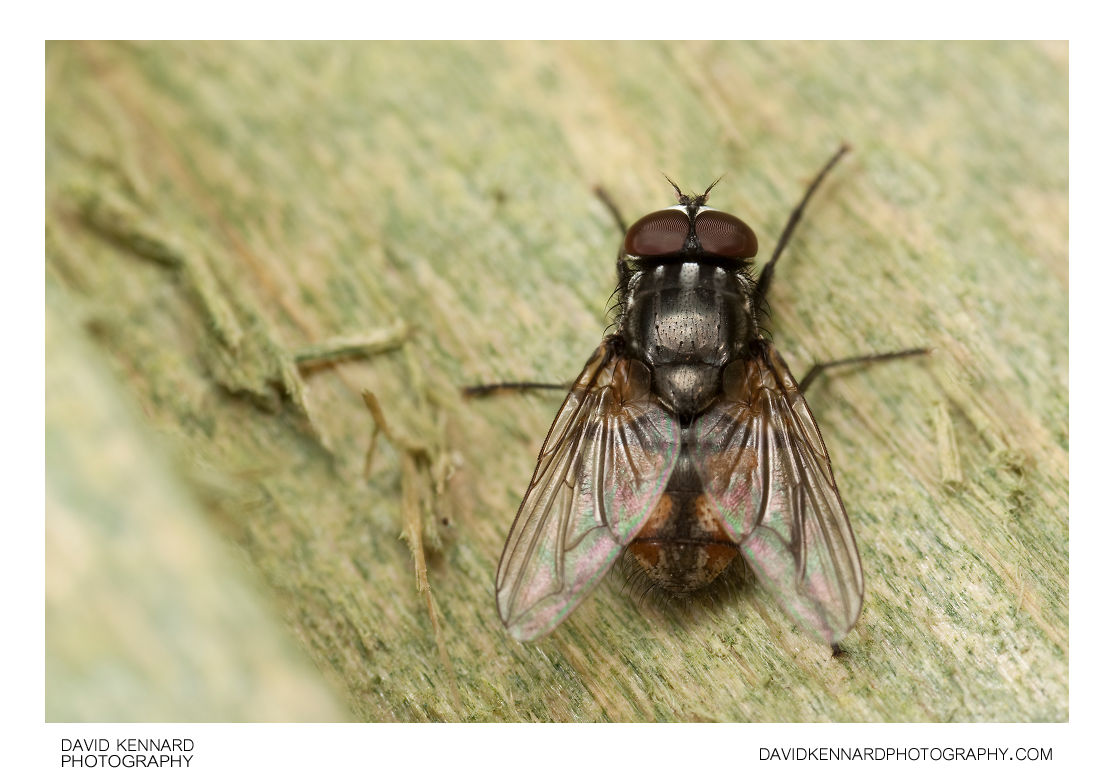Autumn House-fly Musca autumnalis

Description
- Title:
- Autumn House-fly Musca autumnalis
- Caption / Description:
-
Musca autumnalis, the face fly or autumn house-fly, is a pest of cattle and horses
The face fly is similar to the closely related house fly. Slightly larger, averaging about 7 - 8 mm long and Grey in colour with 4 dark stripes on the thorax, with a grey-black patterned abdomen. Like many true flies, in the males, the eyes almost touch when viewed from above.
Musca autumnalis is widespread throughout Most of Europe, Central Asia, also North India, Pakistan, China, and some parts of North Africa.
It has been introduced into North America around the 1940s, and now spread to cover from Southern Canada into most temperate parts of the United States. also introduced to St Helena Island in the South Atlantic.Adult flies will emerge from winter hibernation around March to early April. Daytime they feed on manure juices and plant sugars. On cattle and horses they feed on secretions of the facial orifices, around the eyes, mouth and nostrils. The adult flies will also feed on the hosts blood through wounds such as Horse-fly bites. A larger proportion of face flies on the host will be females, as they have a higher need for protein provided by animal hosts. Night time both sexes will rest on vegetation.
Females deposit eggs on fresh cow manure, and these hatch within hours post deposition. The yellowish white maggots feed on the microbial flora and fauna of the manure and pass though three larval stages (instars), growing to about 12mm long. Then develop into a white pupa. Emerging as Adults approximately 10 to 20 days after egg deposit, dependent on temperature.
Musca autumnalis is considered a pest species, as it transmits eyeworm Thelazia rhodesi to cattle and horses, and Pinkeye (Infectious bovine keratoconjunctivitis) in Cattle.
Description from Wikipedia: http://en.wikipedia.org/wiki/Musca_autumnalis
- Tags / Keywords:
-
- Biota
- Life
- Vitae
- Eukaryota
- Animalia
- Animals
- Arthropoda
- Arthropods
- Insecta
- Insects
- Diptera
- Flies
- Muscidae
- Musca
- Musca autumnalis
- Autumn house-fly
- Face fly
Admin
- Date Original Photo Taken:
- Original File Name:
- _MG_8630-2.psd
- Event:
- Rating:
- ☆
- Date this image added/last updated on website:
- Original File Dimensions:
- 4272px x 2848px
- File Type:
- JPEG
- Color Mode:
- Original Image Color Profile:
- Adobe RGB (1998)
Location
- Location Created:
-
- Sublocation:
- City:
- Market Harborough
- Province/State:
- Leicestershire
- Country:
- United Kingdom
- World Region:
- Europe
- Geo-location:
Rights
- Copyright Status:
- Copyrighted
- Licensing Status:
- Rights Managed
- Available for Editorial Use:
- Yes
- Available for Commercial Use:
- Yes
- Copyright Notice:
- © 2010 Dave Kennard
Camera Data
- Date Digital Resource was created:
- Shutter speed:
- 1⁄200 s
- Aperture:
- f/8
- Camera Model:
- Canon EOS 450D
- ISO:
- 100
- Exposure Compensation:
- 0
- Focal Length:
- 65mm
- Focal Length (35mm equiv.):
- Metering Mode:
- Multi-segment
- Flash:
- On, Fired
- Exposure Mode:
- Manual
- White Balance:
- Manual
- Light Source:
- Exposure Program:
- Manual
Additional shooting metadata
- Lens:
- Canon MP-E 65mm F2.8 1-5x Macro
- Filters used:
- Additional Optics used:
- Setup:
- Handheld
Canon MT-24EX Macro Twin Flash with home-made diffusers
2 shots
Post Processing
- Image Modified:
- Software used:
-
- Adobe Photoshop CS4
- Adobe Camera RAW
- Post Processing:
CR2s converted in ACR
Images combined for focus in Photoshop CS4
